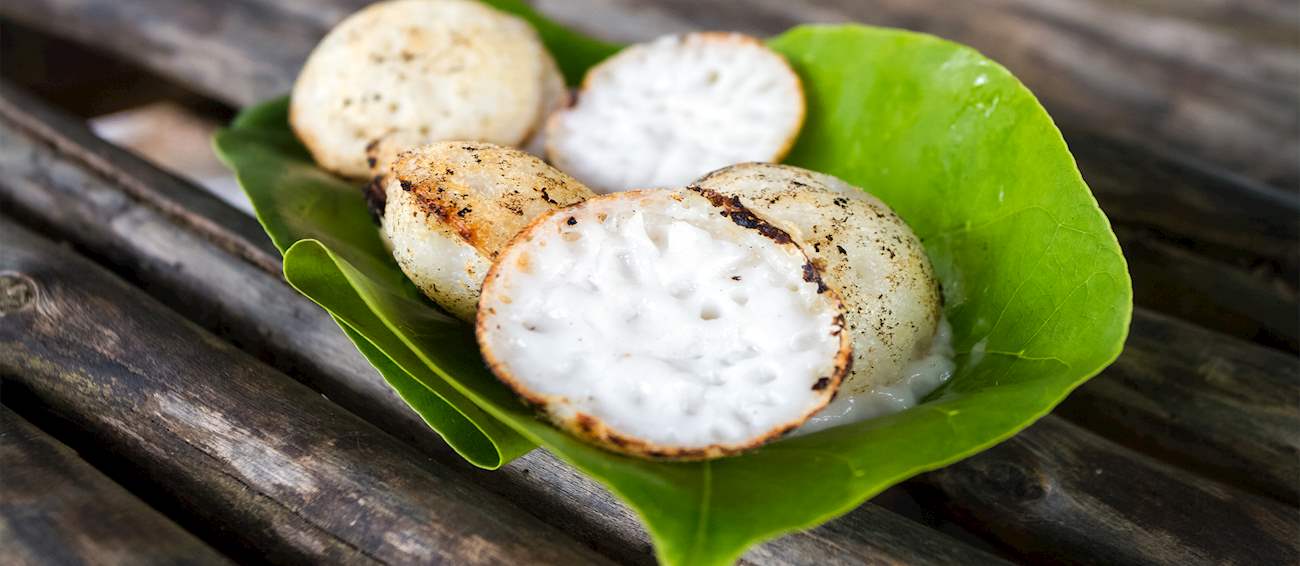MAIN INGREDIENTS
Roti canai is a traditional pan-fried flatbread made with flour, water, eggs, and fat of Indian origin, but mainly associated with Malaysia, and surrounding countries like Indonesia, Brunei, and Thailand. The dough for roti canai is repeatedly folded, so the final product has a layered texture, a soft interior, and a crispy outer layer.
The most common fat used in roti canai is ghee, the traditional Indian clarified butter. It is believed that the dish originated in India when the Indian laborers who migrated to Malaysia brought the recipe and the tradition of preparing this crispy pastry to the foreign country.
VARIATIONS OF Roti canai
This small-sized Thai dessert, which is often referred to as a pancake, pudding, or a cake, is created with a batter that combines rice flour and coconut milk. The dessert is baked in large iron pans that have small, round indentations, and it is typically prepared in two stages—with a batter that is used as a crispy bottom layer, and a creamy, lightly sweetened coconut milk filling.
Typical additions to the custard-like filling include sliced scallions, taro, corn, or pumpkin. Khanom khrok is a staple street food in Thailand, typically enjoyed as a quick and filling snack that balances sweet and savory flavors extremely well.
MAIN INGREDIENTS
A classic Thai dish called thot man kung typically consists of shrimp or prawn mixture, shaped into small, round flat cakes or balls, which are then rolled in panko breadcrumbs and deep-fried until golden and crispy. Other variations of this dish call for different types of seafood, fish, or meat instead of shrimp.
With a crunchy texture and a tender bite, these delicious shrimp cakes are usually served as appetizers, paired with a spicy, sweet-and-sour dipping sauce and fresh cucumber and tomato slices on the side.
Nang kai thot is a savory Thai snack consisting of deep-fried chicken skin. Chicken skin is first cooked in boiling water, then drained and seasoned with salt and pepper or dredged in seasoned flour before it is immersed in hot oil to fry until nicely colored and crispy.
The skin portion of the chicken breasts is regarded as the most suitable for this dish, but any part of the skin can be used. There are no standard seasonings for this snack as each street food vendor uses their own unique seasoning mix, but other than the usual salt and pepper, cilantro powder, garlic powder, chicken flavoring powder, and soy sauce are used most often.
Thai fish cakes usually consist of flaked fish, red curry paste, kaffir lime leaves, eggs, thinly sliced green beans, and optionally other additions such as galangal or lemongrass. Traditionally, the dish is made with fresh clown featherback (pla grai) fish.
The cakes are best enjoyed freshly fried and served with cucumber relish, sriracha, or chili sauce. In Thailand, they are usually consumed as an appetizer or a quick and convenient street food, but they can also make a filling main course when served with rice on the side.
Sai krok Isan is a fermented sausage from the Isan region. It is made with a mixture of ground pork meat and fat, combined with garlic, sticky rice, salt, and pepper in a natural encasing. The sausage is then allowed to dry and ferment for several hours or sometimes even for up to 2-3 days in a blazing hot sun, a method that provides this sausage with its unique sourness.
Salty with a hint of sourness, these flavorful sausages are usually grilled or fried and served alongside raw chilis, fresh ginger slices, garlic, and fresh vegetables. Thais consume them for breakfast or buy them from local street carts as delicious snacks that are grilled on a stick and consumed on the go.
Roti sai mai is a sweet Thai snack consisting of a pandan-flavored pancake (roti) that is filled with cotton candy. The pan-fried pancake is similar to a crêpe, and it has a distinctive green color attained from the addition of pandan. The dish is believed to have originated in Ayutthaya, primarily among the Muslim community.
It is usually sold by vendors who prepare it on street stalls.
Kue cucur is a traditional snack that's also popular in Malaysia (kuih cucur) and Thailand (khanom fak bua). It's made with a combination of palm sugar, fried rice flour, and coconut milk that's fried until crispy. This sweet snack is usually flattened on the edges so that it remains thick in the middle.
The most popular Indonesian version is the Betawi variety from Jakarta. In Thailand, kue cucur is similar to a lotus, which is believed to represent love of a newly married couple, so it's often prepared at Thai weddings and festivals. Kue cucur is served hot, warm, or at room temperature, and it's best to eat it while it's still fresh, otherwise it will become sticky and stiff.
Fried pork rinds are a popular Thai snack that is prepared with cured or dried pork skin. Some fat is usually left on the skin, and the curing process helps the rind attain its typical puffed and crispy texture. Khaep mu is enjoyed as a snack when it is usually accompanied by chili-based nam phrik sauces.
It can also be served as a side dish, and when crumbled, it is often added to various dishes as an ingredient or a garnish. This filling snack is traditionally associated with northern Thailand, and it is commonly sold by street vendors.
MAIN INGREDIENTS
Kluai thot, or deep-fried bananas, is a sweet street food item commonly found throughout Thailand. This Thai treat is traditionally prepared with peeled and sliced burro bananas, known locally as kluay nam wa, which are entirely immersed in a thin rice flour mixture, and then fried in hot oil until they form a crispy crust.
The batter mixture usually consists of rice flour, all-purpose flour, sesame seeds, baking powder or traditionally slaked lime, baking soda, sugar, salt, ripe coconut shreds, and water. Sweet and crunchy, fried bananas are typically sold in bags and enjoyed while they are still warm, usually as a snack, a dessert, or an appetizer.
TasteAtlas food rankings are based on the ratings of the TasteAtlas audience, with a series of mechanisms that recognize real users and that ignore bot, nationalist or local patriotic ratings, and give additional value to the ratings of users that the system recognizes as knowledgeable. TasteAtlas Rankings should not be seen as the final global conclusion about food. Their purpose is to promote excellent local foods, instill pride in traditional dishes, and arouse curiosity about dishes you haven’t tried.















